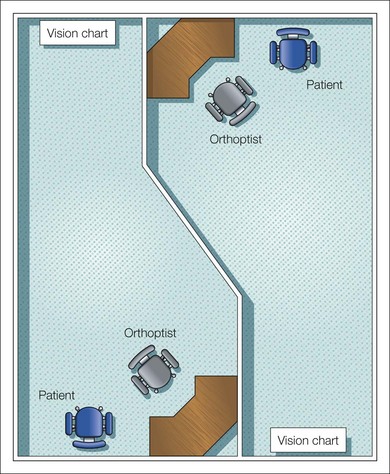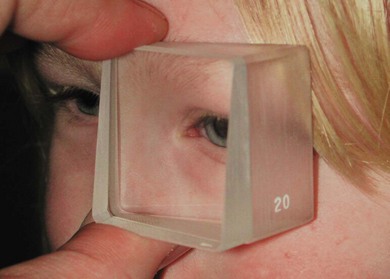Chapter 72 The clinical approach to strabismus
The clinical setting
Room layout
Other factors determining the length of the examination room are the minimum distance required to prevent accommodation affecting the basic deviation measurement and other distance tests such as distance stereopsis and fusion tests. The maximum amount of accommodation when viewing an accommodative target at 6 m is about an eighth of a diopter, which is clinically insignificant. At 4 m accommodation is not completely suspended and could influence the basic deviation measurement (angle of deviation in the primary position for distance with accommodation suspended). At least some rooms should be 6 m in length to best perform accurate motility testing. However, these rooms do not need to be rectangular. To make the best use of limited floor area the rooms can “interlock” so that there is a wide end for the examiner and patient and a thin end for the fixation and acuity targets (Fig. 72.1).
Distance fixation and acuity targets
Obtaining accurate results for the basic deviation measurement in children can be challenging. Failure to achieve an accurate measurement for distance is a common cause of surgical error, as many children with strabismus have a disparity between distance and near deviation. Operating on the near angle (which is easier to measure) may result in an over- or undercorrection for distance. Interesting distance fixation targets are essential in the management of childhood strabismus. The letters of a Snellen acuity chart will not hold the child’s attention for long. A variety of fixation targets are necessary, some requiring greater resolution than others. Cartoon characters and soft toys arranged at 6 m provide more interest for the child. DVDs can be displayed on a TV screen and there are many computer based fixation and acuity programs available (including Apps for iPads and mobile phones) (Fig. 72.2).
Tools of the trade
When assessing strabismus, there are a number of useful items (Fig. 72.3). The list is not exhaustive but emphasizes that if the equipment is not at hand, the test will not be done.
1. Occluder for performing cover tests: a transparent (Spielmann) occluder allows visualization of the occluded eye.
2. Single prisms (Berens’ square prisms are the most accurate) for performing prism cover tests: single prisms have a number of advantages over prism bars. The larger prism area allows better visualization of the fixation targets by the patient, and allows better visualization of the eye by the examiner. Both horizontal and vertical deviations can be corrected simultaneously in front of the same eye (Fig. 72.4).
3. Near acuity target for determining the near angle as accommodative demand is increased (particularly useful in assessing children with convergence excess esotropia).
4. Near stereoacuity tests (Lang, Frisby, TNO, Wirt).
5. Maddox rods or Bagolini lenses for measuring torsion.
Interaction with the child and parents
First meeting
Several methods for getting the most information out of the first visit can be employed:
1. Observation: this can be performed while talking to the parents or while the child plays. Look at the visual behavior and look for an abnormal head posture or obvious strabismus.
2. Lang stereotest: this can be made into a game, which can be played first by a parent or sibling. It is a good initial test because it is not intimidating (it does not require special glasses to be worn).
3. Distance fixation using DVDs: children’s DVDs playing at the far end of the examination room are a useful distance fixation target to enable cover testing and determining fixation preference.
4. Cycloplegic drops: cyclopentolate 1% instilled 30 minutes before refraction is adequate for most children. Best results are obtained if someone other than the examiner, in a separate room, instills them. Topical anesthetic (proxymetacaine 0.5%) reduces the discomfort of the cycloplegic drops considerably and should be considered. Atropine 1% can be used if cycloplegia with cyclopentolate cannot be obtained. If the child finds instillation of drops in the clinic very traumatic, atropine drops or ointment can be instilled at home by the parents prior to the clinic appointment.
5. If a fundus view is not achieved, another attempt should be made at a later date. It is occasionally necessary to physically restrain a child for fundus examination if there is suspicion of fundus pathology.
6. Examination of the optic nerve should include a magnified view. This can be achieved with a direct ophthalmoscope or by slit-lamp biomicroscopy, which gives a much better view. It is important to recheck the fundus and disc appearance in children with amblyopia refractory to treatment to exclude other causes of poor vision such as optic nerve hypoplasia.
7. Hand-held slit-lamp: it is possible to look at children with an adult slit-lamp, but examining small children is easier with a hand-held slit-lamp.
Practical history taking: extracting clinically relevant details
1. The parents’ observations about the strabismus: whether the eyes turn in or out, which eye is most commonly affected, whether the strabismus is intermittent or constant, and changes in the strabismus when the child is tired or unwell.
2. Other ophthalmic symptoms: whether there are any associated abnormalities such as closing one eye in bright light, whether double vision is experienced, and whether the parents have noticed a vertical element to the strabismus or an association with changes in lid height.
3. Past ophthalmic history: whether there is any history of ophthalmic care (including glasses or patching), trauma, or previous strabismus surgery.
4. Past medical history: previous history of systemic or neurologic disease; the pregnancy, delivery and developmental history; and the drug and allergy history.
5. Family history: whether there is a family history of glasses wear in childhood, lazy eyes, or strabismus surgery; and whether there is a family history of either ophthalmic or systemic inherited disease.
Examination
Examination of the strabismus patient should include:
• A sensory examination (acuity, fixation preference, binocular vision, fusion, accommodation, and convergence).
• Ocular examination (slit-lamp examination, media and fundus examination).
Further specific examination including a search for dysmorphic or neurologic signs may be necessary.
Sensory examination
Acuity
logMAR-based matching tests
At about  to 4 years most children will be able to perform a logMAR-based matching test, which can be presented on cards1 or on a screen.2 These give accurate and reproducible acuity results.
to 4 years most children will be able to perform a logMAR-based matching test, which can be presented on cards1 or on a screen.2 These give accurate and reproducible acuity results.
Fixation preference
Fixation preference is a simple and effective test for detecting amblyopia and can be performed in infants. It is most accurate with strabismus of 10 prism diopters or more. Fixation preference is analyzed by assessing the centrality, steadiness, and maintenance of fixation (CSM method). “Central” fixation requires that the corneal reflex is central in the pupil. “Steady” fixation requires no evidence of nystagmus or oscillatory eye movements. “Maintained” fixation refers to the ability of the non-preferred eye to maintain fixation after occlusion is removed from the preferred eye. This can be graded by determining whether the fixation is maintained through a blink or during a smooth pursuit movement, or by observing the time period through which fixation is maintained by the non-preferred eye when occlusion is removed from the preferred eye.3







